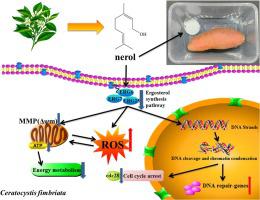当前位置:
X-MOL 学术
›
Postharvest Biol. Technol.
›
论文详情
Our official English website, www.x-mol.net, welcomes your
feedback! (Note: you will need to create a separate account there.)
Antifungal effect of nerol via transcriptome analysis and cell growth repression in sweet potato spoilage fungi Ceratocystis fimbriata
Postharvest Biology and Technology ( IF 6.4 ) Pub Date : 2021-01-01 , DOI: 10.1016/j.postharvbio.2020.111343 Xuezhi Li , Man Liu , Tinggong Huang , Kunlong Yang , Sihan Zhou , Yongxin Li , Jun Tian
Postharvest Biology and Technology ( IF 6.4 ) Pub Date : 2021-01-01 , DOI: 10.1016/j.postharvbio.2020.111343 Xuezhi Li , Man Liu , Tinggong Huang , Kunlong Yang , Sihan Zhou , Yongxin Li , Jun Tian

|
Abstract Ceratocystis fimbriata is the most devastating phytopathogen causing significant losses in post-harvest sweet potato. In this study, monoterpene nerol (NEL), the active compound in neroli essential oil, was found to dose-dependently inhibit the mycelial growth and spore germination of C. fimbriata at a minimum inhibitory concentration (MIC) of 0.25 mL L-1. NEL vapor treatments significantly reduced the incidence and lesion diameter of black rot in sweet potato infected by the fungus and regulated the defense-related enzyme activity of phenylalanine ammonia lyase (PAL). Using RNA sequencing (RNA-seq) and biochemical assays, it was demonstrated that NEL treatment impaired cell membrane integrity via down-regulating the expression of ergosterol synthesis genes and reduced the ergosterol content. Moreover, an analysis of a series of apoptotic events revealed that NEL treatment caused mitochondrial membrane damage by reducing the mitochondrial membrane potential (MMP, Δψm), which led to down-regulation of genes involved in ATP production, then induced accumulation of intracellular reactive oxygen species (ROS) generation. Simultaneously, NEL caused nuclear chromatin condensation and concomitant DNA cleavage, which led to the up-regulation of DNA repair genes expression, and the cell-cycle arrest principally occurred at the G2/M phase in C. fimbriata. Altogether, these findings provide information about the underlying antifungal mechanism of NEL against C. fimbriata and suggest that NEL could be a useful alternative for controlling C. fimbriata in post-harvest spoilage of sweet potato.
中文翻译:

通过转录组分析和抑制甘薯腐败真菌 Ceratocystis fimbriata 细胞生长抑制橙花醇的抗真菌作用
摘要 Ceratocystis fimbriata 是最具破坏性的植物病原体,对收获后的甘薯造成重大损失。在这项研究中,发现橙花精油中的活性化合物单萜橙花醇 (NEL) 以剂量依赖性方式抑制 C. fimbriata 的菌丝生长和孢子萌发,最低抑制浓度 (MIC) 为 0.25 mL L-1。NEL蒸气处理显着降低了真菌感染的甘薯黑腐病的发生率和病斑直径,并调节了苯丙氨酸解氨酶(PAL)的防御相关酶活性。使用 RNA 测序 (RNA-seq) 和生化测定,证明 NEL 处理通过下调麦角甾醇合成基因的表达并降低麦角甾醇含量来损害细胞膜完整性。而且,对一系列凋亡事件的分析表明,NEL 治疗通过降低线粒体膜电位(MMP,Δψm)导致线粒体膜损伤,导致参与 ATP 产生的基因下调,然后诱导细胞内活性氧的积累。 ROS)生成。同时,NEL 引起核染色质浓缩和伴随的 DNA 切割,导致 DNA 修复基因表达上调,细胞周期停滞主要发生在 C. fimbriata 的 G2/M 期。总之,这些发现提供了关于 NEL 对 C. fimbriata 的潜在抗真菌机制的信息,并表明 NEL 可能是控制 C. fimbriata 在甘薯收获后腐败中的有用替代方法。
更新日期:2021-01-01
中文翻译:

通过转录组分析和抑制甘薯腐败真菌 Ceratocystis fimbriata 细胞生长抑制橙花醇的抗真菌作用
摘要 Ceratocystis fimbriata 是最具破坏性的植物病原体,对收获后的甘薯造成重大损失。在这项研究中,发现橙花精油中的活性化合物单萜橙花醇 (NEL) 以剂量依赖性方式抑制 C. fimbriata 的菌丝生长和孢子萌发,最低抑制浓度 (MIC) 为 0.25 mL L-1。NEL蒸气处理显着降低了真菌感染的甘薯黑腐病的发生率和病斑直径,并调节了苯丙氨酸解氨酶(PAL)的防御相关酶活性。使用 RNA 测序 (RNA-seq) 和生化测定,证明 NEL 处理通过下调麦角甾醇合成基因的表达并降低麦角甾醇含量来损害细胞膜完整性。而且,对一系列凋亡事件的分析表明,NEL 治疗通过降低线粒体膜电位(MMP,Δψm)导致线粒体膜损伤,导致参与 ATP 产生的基因下调,然后诱导细胞内活性氧的积累。 ROS)生成。同时,NEL 引起核染色质浓缩和伴随的 DNA 切割,导致 DNA 修复基因表达上调,细胞周期停滞主要发生在 C. fimbriata 的 G2/M 期。总之,这些发现提供了关于 NEL 对 C. fimbriata 的潜在抗真菌机制的信息,并表明 NEL 可能是控制 C. fimbriata 在甘薯收获后腐败中的有用替代方法。











































 京公网安备 11010802027423号
京公网安备 11010802027423号